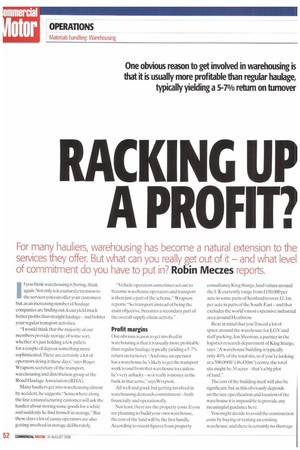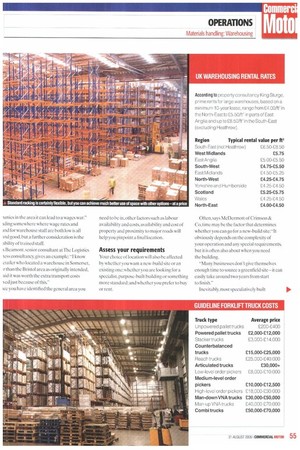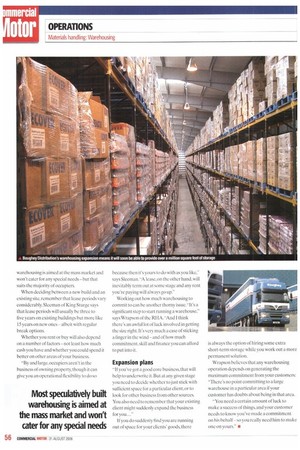RACKING UP A PROFIT?
Page 52

Page 54

Page 55

Page 56

If you've noticed an error in this article please click here to report it so we can fix it.
For many hauliers, warehousing has become a natural extension to the services they offer. But what can you really get out of it — and what level of commitment do you have to put in? Robin Meaes reports.
If you think warehousing is boring, think again. Not only is it a natural extension to the services you can offer your customers but, as an increasing number of haulage companies are finding out,it can yield much better profits than straight haulage-and bolster your regular transport activities.
"I would think that the majority of our members provide storage of some sort, whether it's just holding a few pallets for a couple of days or something more sophisticated.There are certainly a lot of operators doing it these days," says Roger Wrapson, secretary of the transport, warehousing and distribution group at the Road Haulage Association (RHA).
Many hauliers get into warehousing almost by accident, he suggests: "Somewhere along the line a manufacturing customer will ask the haulier about storing some goods for a while and suddenly he find himself in storage." But these days a lot of canny operators are also getting involved in storage deliberately. "Vehicle operators sometimes set out to become warehouse operators and transport is then just a part of the scheme,Wrapson reports."So transport, instead of being the main objective, becomes a secondary part of the overall supply-chain activity.
Profit margins
One obvious reason to get involved in warehousing is that it is usually more profitable than regular haulage. typically yielding a 5-7% return on turnover. "And once an operator has a warehouse he's likely to get the transport work to and from that warehouse too, unless he's very unlucky-so it really is money in the bank in that sense,says Wrapson.
All well and good, but getting involved in warehousing demands commitment both financially and operationally.
Not least, there are the property costs. If you are planning to build your own warehouse, the cost of the land will be the lirst hurdle. According to recent figures from property consultancy King Sturge, land values around the UK currently range from £150,000 per acre in some parts of Scotland to over £1.1m per acre in parts of the South-East-and that excludes the world's most expensive industrial area around Heathrow.
Bear in mind that you'll need a lot of space around the warehouse for LGV and staff parking, Jon Sleeman. a partner in the logistics research department of King Sturge, says: "A warehouse building is typically only 40% of the total site, so if you're looking at a 500,000ft= (46,450m-') centre, the total site might be 30 acres that's a big plot of land.
The cost of the building itself will also be significant, but as this obviously depends on the size, specification and location of the warehouse it is impossible to provide any meaningful guidance here.
You might decide to avoid the construction costs by buying or renting an existing warehouse, and there is certainly no shortage of choice— availability of speculatively developed sites in the UK is at its highest level for five years, according to King Sturge.
As you would expect, property prices and rents vary widely from region to region, with hot spots such as the South-East, the West Midlands and the MI corridor being among the most expensive areas.
Once you have sorted out the basic warehouse shell, you will need to budget for the essential materials handling and storage equipment — lift trucks and racking. Again, the exact costs will come down to specification.
Simple counterbalanced forklifts, for instance, should cost between £15,000 and f25,000 apiece, but they can only operate in aisles at least three metres wide. Specialist forklifts able to work in half the width will allow more space for racking but they will set you back 00,000-00,000 a time. Other options however, like reach trucks, represent a good compromise between these two extremes.
In any case, your racking options aren't limited to aisle widths. Standard adjustable pallet racking (APR), available in wide or narrow aisle configuration, is the cheapest and most flexible option as it gives access to all pallets at all times.
Other fon-ns of racking include: • Double deep racking, in which each position houses two pallets, one behind the other; • Drive-in racking, where pallets are placed on longitudinal rails and forklifts literally drive in to get at the nearest one, doing away with the need for individual bays and aisles; • Live storage, where pallets are stored several deep on an inclined roller bed so when the front pallet is removed, the others glide forward to the pick face.
These can dramatically increase the storage density you can achieve, albeit at greater cost per pallet position and with the penalty of reduced access to individual pallets.
That cost and penalty might be worth putting up with if it means you can store (and thus charge for) up 10 80% more in your warehouse than with standard racking. Another major outlay to consider is staff. As a general guideline, budget for one member of staff for every 1,000112 (90m2) of warehousing. According to the latest survey from Incomes Data Services and the RHA, wages for warehouse staff average i6.78/hr, allowing for regional variations.
Labour costs
Getting hold of the right staff with the right skills can be tricky — much depends on where you set up your warehouse. Catherine McDermott, director of industrial consultancy Crimson & Co, warns that in an area where there are lots of other warehouses you will have to compete for local staff.
"Labour is among the biggest costs, so you need to look at the local economy and local wage rates," she adds." If you pick the right location you may get away with paying lower wages and still enjoy low staff turnover.
"But in some parts of the country it is now notoriously difficult to find and keep staff— and if there are a lot of other distribution )anics in the area it can lead to a wages war." iding somewhere where wage rates and ind for warehouse staff are both low is all ind good, but a further consideration is the ability of trained staff.
s Bean-tont, senior consultant at The Logistics less consultancy, gives an example: "I know etailer who located a warehouse in Somerset, ir than the Bristol area as originally intended, aid it was worth the extra transport costs vedjust because of this."
ice you have identified the general area you need to be in, other factors such as labour availability and costs, availability and cost of property and proximity to major roads will help you pinpoint a final location.
Assess your requirements Your choice of location will also he affected by whether you want a new-build site or an existing one: whether you are looking for a specialist, purpose-built building or something more standard: and whether you prefer to buy or rent. Often ,says McDermott of Crimson & Co, time may be the factor that determines whether you can go for a new-build site: "It obviously depends on the complexity of your operation and any special requirements, hut it is often also about when you need the building.
"Many businesses don't give themselves enough time to source a greenfield site — it can easily take around two years from start to finish."
Inevitably, most speculatively built warehousing is aimed at the mass market and won't cater for any special needs —but that suits the majority of occupiers.
When deciding between a new build and an existing site, remember that lease periods vary considerably. Sleeman of King Sturge says that lease periods will usually be three to five years on existing buildings but more like 15 years on new ones — albeit with regular break options.
Whether you rent or buy will also depend on a number of factors —not least how much cash you have and whether you could spend it better on other areas of your business.
"By and large, occupiers aren't in the business of owning property, though it can give you an operational flexibility to do so because then it's yours to do with as you like,says Sleeman."A lease, on the other hand, will inevitably term out at some stage and any rent you're paying will always go up."
Working out how much warehousing to commit to can be another thorny issue. It's a significant step to start running a warehouse," says Wrapson of the RH A."And I think there's an awful lot of luck involved in getting the size right. It's very much a case of sticking a finger in the wind —and of how much commitment, skill and finance you can afford to put into it.
Expansion plans " if you've got a good core business, that will help to underwrite it. But at any given stage you need to decide whether to just stick with sufficient space fora particular client, or to look for other business from other sources. You also need to remember that your existing client might suddenly expand the business for you..."
If you do suddenly find you are running out of space for your clients' goods, there is always the option of hiring some extra short-term storage while you work out a more permanent solution.
Wrapson believes that any warehousing operation depends on generating the maximum commitment from your customers: "There's no point committing to a large warehouse in a particular area if your customer has doubts about being in that area.
-You need a certain amount of luck to make a success of things, and your customer needs to know you've made a commitment on his behalf—so you really need him to make one on yours." •


















































































































































































